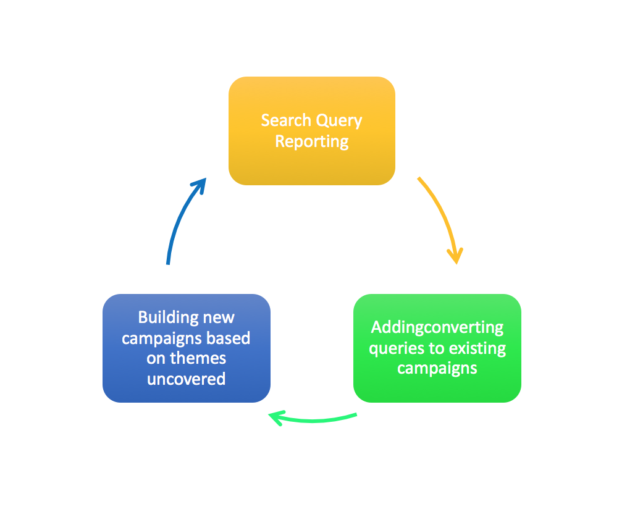I am obsessed with structures. As a kid I would dump out my blue plastic garbage can full of Legos in the middle of the living room and build for hours. Build. Take apart. Re-build. Then there were the times when the thousands of little pieces weren’t enough. I wanted to see just how much I could build so I’d pull the crumpled dollar bills out of my porcelain piggy bank, head to the store, and buy more.
Maybe my childhood obsession with Legos helped fuel my passion for good, solid, PPC campaign structures. Every time I work in an account, my mind is constantly thinking, “how can I make this bigger/better? Where can I expand?” There are many different methods for expanding your PPC campaigns and in this blog, I will explore several options, weighing the pros and cons of each.
Cycle Of Expansion
A common practice for expansion involves the following cycle:

During this cycle, we are looking for gaps—areas of interest we missed or overlooked during our initial builds. This cycle is a necessary process and several external factors can change the way people are searching for your product or service. A former client offered a product that at one point did not get much traffic. In 2013 an NFL star was in the news for using this product. After the news was out, traffic skyrocketed and the campaigns surrounding the product grew exponentially.
The cycle of expansions through search query is the norm. And they 100% should be used when starting to think about expansion ideas. But be wary of trends. As in the example above, when the media stopped covering the NFL star, the traffic fell off.
Top Performers
Another way to use the almighty search query report is to farm for top performing search queries and then build top performer campaigns from those exact queries.
Here is a breakdown of what this process looks like:
- Determine what makes a search query a “top performer” for your account. Think about your goals and conversion volume in determining these qualifications. Maybe a top performing query pulled in just 2 conversions in the past 30 days. Or maybe the threshold is 15 conversions in 14 days. The point is, you are in control of setting the expectations for top performers.
- Create exact match single keyword ad groups, or SKAGs, from these queries. Make sure your bids are aggressive.
- Add exact match negatives back to the ad groups from which the queries originated.
This is a fantastic strategy for expansion and building new campaigns. Time and time again, accounts at Hanapin have seen great improvement in performance. Here’s the kicker: it doesn’t always work.
In theory, top performer campaigns should always work. You are giving your top searches their own budgets and ad groups. You can write super-targeted ads. You can send them to specific landing pages. You are elevating them above the rest. You do everything by the book and inexplicably it just doesn’t work.
Recently, I used this strategy to boost performance and spend in an account. No matter how much I sweet-talked and nudged the top performers to actually perform, conversions tanked. As you can see below, things were not going my way.

So my advice on top performers is this. It is a good strategy for expansion and building new campaigns, but don’t just walk away and hope it does its thing. Be prepared to tweak things and to tear down the structure if it doesn’t work.
Testing New Keywords
Aside from SQRs, you may find yourself wanting to test new targeting. While I appreciate and use keyword planner tools within Google and Bing’s respective UIs, I am also a firm believer in the saying “you just don’t know until you try.” Building out a specific campaign just devoted to new targeting initiatives can be a great way to safely test and control ideas. By using a separate campaign for new targeting, you don’t run the risk of having test keywords eat up a bunch of budget or tank quality score.
Restructuring
Sometimes all you need for expansion is a good old restructure. Take apart your campaigns and put them back together again in a new way. Why is this strategy a good idea for expansion? Sometimes certain keywords or ad groups need more budget in order to grow. Quality score could be holding other keywords back. Or maybe you inherited an account where all of your figurative Legos are in one big jumbled campaign.
Take a look at the current structure and ask yourself the following questions.
- Is there anything about this structure that is holding back the account from growing?
- Does the structure accurately reflect goals and initiatives?
- Where are budget restraints holding back keywords?
- Are things neat and tidy?
There are a couple reports I like to run to help me determine if a restructure is necessary. And if by running these reports you determine it isn’t necessary, that doesn’t mean you can’t try something new in efforts to expand.
Just like testing new things and top performer campaigns, the downside is that sometimes things just don’t work the way you intend. Be prepared to go back to your original structure and go back to the drawing board. With restructures, you have all your pieces in front of you. You don’t need to go out and find more keywords, you just need to rework what you already have.
Conclusion
I venture to guess that most if not all advertisers in PPC want to see results go up and to the right. This isn’t always possible due to seasonality, trends, etc. But as PPC experts, we should always be thinking of ways to expand and try new ideas. Just as the standard answer to many questions about PPC strategy involve the two words “it depends,” trying new ideas is essential to growth and expansion.
As I got older, my obsession with Legos transformed. Instead of taking apart Lego towers, I started taking apart other things—like my boombox and my computer. I wanted to understand how all of the little parts worked together. Unfortunately, I was not some kid prodigy who actually understood how to build electronics. Many a Walkman lost their life at my hands. But now, as I am settled into my PPC career, I am still fascinated by taking things apart and seeing if I can put them back in a more interesting way. Fortunately for me, PPC is much more forgiving and trial and error is a way of life.



